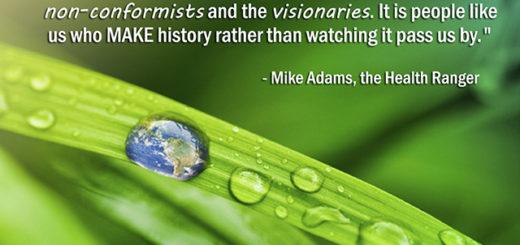Pick Your Poison-American Food
By Dr. Mercola
How many chemicals are you exposed to on a daily basis? There’s no way to know for sure, but chances are toxic chemicals are in your food and many items you touch hundreds, if not thousands, of times a day.
What is known that your toxic burden is largely related to your purchasing decisions and lifestyle. While environmental pollution is certainly a factor, primary routes of chronic exposure include your diet, and personal care and household products.
Tests have confirmed that those who eat non-organic foods and use chemical-based products tend to have far higher levels of toxins in their system. Your choice of building materials and furniture can also play a role, as many contain toxic chemicals like flame retardants.
Toxins in Food and Plastics Are Fueling Chronic Disease
Health statistics suggest the toxic burden is becoming too great for children and adults alike, and toxins in our food appear to play a primary role.
According to Joseph E. Pizzorno,1 founding president of Bastyr University, toxins in the modern food supply are now “a major contributor to, and in some cases the cause of, virtually all chronic diseases.”
Dr. David Bellinger, a professor of Neurology at Harvard Medical School has expressed similar concerns. According to his estimates, Americans have lost a total of 16.9 million IQ points due to exposure to organophosphate pesticides.2
Most recently, a report3,4 by the International Federation of Gynecology and Obstetrics5 warns that chemical exposures now represent a major threat to human health and reproduction.
An Endocrine Society task force also recently issued a new scientific statement6,7 on endocrine-disrupting chemicals, noting that the health effects of hormone-disrupting chemicals are such that everyone needs to take proactive steps to avoid them.
The statement also calls for improved safety testing to determine which chemicals may cause problems.
Our Daily Poison
Written and directed by Marie-Monique Robin, the featured film “Our Daily Poison” delves into these kinds of issues, covering a spectrum of poisons that most people are exposed to on a regular basis. This includes:
- Agricultural chemicals
- Artificial sweeteners like aspartame and other food additives
- Endocrine-disrupting chemicals like phthalates and bisphenol-A (BPA)
The film also discusses “the cocktail effect” — interactions between chemicals that render the sum total more harmful than the risks associated with any given chemical in isolation.
Conventional Farming Can Be Hazardous to Your Health
With the advent of the “green revolution” starting in the 1930s, chemicals became agents of choice and were widely embraced as the way to eradicate hunger and ensure abundance.
Agricultural chemicals such as pesticides were said to be responsible for providing the Western world with the highest living standard the world had ever known.
In this chemistry-based model, there’s a chemical for every problem: pesticides to kill pests, herbicides to address weeds, insecticides to get rid of specific insects, fungicides against mushrooms and fungi, and so on.
But, as the decades wore on, problems and drawbacks of this system became apparent. For starters, farmers became increasingly vulnerable to diseases and chronic ailments related to toxic exposures — many of which came as a complete surprise to farmers who believed such chemicals were safe.
The film features a group of about 30 French farmers, who for more than 15 years have fought against the use of pesticides in France after becoming severely ill from either acute or long-term exposure.
Studies have indeed shown both farm workers and rural residents living near farms are at increased risk of certain diseases, including Parkinson’s disease, which has been linked to pesticide exposure.
Pesticides, herbicides, and fungicides are potent toxins that can damage your neurological system, including your brain. Even extremely low-level pesticide exposure has been found to considerably increase the risk of Parkinson’s disease.
Certain types of cancer are also more prevalent among agricultural workers than the general population.
Common Side Effects of Agricultural Chemicals
Different chemicals are associated with different side effects:
- Insecticides primarily produce neurological symptoms, such as headaches
- Fungicides tend to produce skin-related symptoms
- Herbicides are associated with digestive and skin problems
Glyphosate, one of the most widely used herbicides in the world, has been linked to an array of health effects, including:8,9
Roundup Formulation Is Likely Far Worse Than Glyphosate
Glyphosate is the active ingredient in Monsanto’s broad spectrum herbicide Roundup. This herbicide is most heavily applied on genetically engineered (GE) corn, soybeans, and sugar beets, but it’s also commonly used to desiccate conventional (non-GMO but non-organic) wheat and protect other conventional crops from weeds.
While the dangers of glyphosate are quickly becoming more widely recognized, many fail to realize that the Roundup formulation is even more toxic than glyphosate, because the surfactants in the formula synergistically increase glyphosate’s toxicity.
Recent research14,15 by Gilles-Éric Séralini — whose initial lifetime feeding study revealed massive tumor growth and early death — shows that long-term exposure to even ultra-low amounts of Roundup can cause cancer, along with liver and kidney damage in rats. The dose used in this study was “environmentally relevant in terms of human, domesticated animals, and wildlife levels of exposure,” prompting the authors to suggest Roundup may have significant implications for health.
As revealed in the featured film, pesticides are not safe, and the science backing their use on the field, and the safety of consuming traces of them on food, has been largely produced by groups that have significant conflicts of interests. The chemical industry also has a perpetually revolving door with the regulatory agencies, which has allowed unreasonably hazardous chemicals to be used in the growing of our food.
The film also reveals the history and questionable use of Acceptable Daily Intake (ADI) and the Maximum Residue Limit (MRL) as assurances of the “safe” level of pesticides in the diet. While many believe these measures are based on sound science, in reality, there’s plenty of guess work involved in calculating these limits.
Many Food Chemicals Are Unregulated
While the regulatory system governing agricultural chemicals is dysfunctional and flawed, other chemicals used in food production are not regulated at all… In the US, food additives are not automatically required to get premarket approval by the US Food and Drug Administration (FDA).16,17,18,19,20 As explained in the video above, items that fall under the “generally recognized as safe” (GRAS) designation are exempt from the approval process, and food manufacturers routinely use this loophole to add novel ingredients without FDA oversight.
This is also how Monsanto and other agribusinesses sneaked GMO foods into our food supply, as the FDA classified them as GRAS in 1992. Steven Druker revealed in my interview with him how his lawsuit to reverse this was lost on technicalities.
The law that provides this unfortunate loophole is the 1958 Food Additives Amendment. It excludes GRAS items from the formal FDA approval process for food additives, and while it doesn’t make sense today, it did at the time it was written. In 1958, GRAS exemptions applied to common food ingredients like vinegar and baking soda — regular cooking ingredients known through their historical use as being safe. However, times have changed, and so has food chemistry. Food manufacturers of today use chemicals in food processing that would have been inconceivable in 1958.
A major part of the problem is that food companies are allowed to determine, on their own, whether an ingredient is GRAS. To do this, all they have to do is hire an industry insider to evaluate the chemical, and if that individual determines that the chemical meets federal safety standards, it can be deemed GRAS.
At that point, the company doesn’t even need to inform the FDA that the ingredient is used, and no independent third party objective evaluation is required. This process allows food manufacturers to market novel chemicals in their products based on absolutely nothing except their own safety assessments — the results of which can be kept a secret.
According to Center for Science in the Public Interest (CSPI),21,22 at least 1,000 ingredients are added to our food that the FDA has no knowledge of. One now “classic” example of the GRAS process gone awry is artificial trans fat, which was originally considered GRAS. Decades later and faced with a mountain of scientific evidence, the FDA has now deemed trans fat dangerous, saying it causes as many as 7,000 deaths from heart disease each year, and has withdrawn the GRAS designation from hydrogenated vegetables oils.
Fascinating Example of How Funding Bias Can Influence Science
The film also touches on how the regulatory process was manipulated to allow aspartame into the food supply. There are a number of well-written books on the market that detail the twists and turns of this part of history. A Harvard law summary of the legal wrangling23 that took place is also a worthwhile read if you’re confused about how a toxin like aspartame could possibly be allowed in the food supply.
Aspartame gained FDA approval in the US in 1981, with a daily ADI of 50 mg/kg. In Europe, the European Food Safety Authority set the ADI at 40 mg/kg. While aspartame can be found in some 6,000 different food products, diet soda accounts for a majority of the aspartame consumed. A 12 ounce can of diet soda can contain upwards of 180 mg of aspartame — well over the ADI of both the US and Europe.
The safety of aspartame has been debated since well before its FDA approval, and if you’ve been inclined to believe the claims that aspartame has been well-studied and found safe, the following review of the science just might make you reconsider…
In 1996, Dr. Ralph G. Walton, a physician and professor of Clinical Psychiatry reviewed 165 aspartame studies24,25 believed to be relevant to human safety. What he found was a remarkable discrepancy between study results and their source of funding. Of the 165 studies, 74 had industry-related funding (such as Searle, Nutrasweet®, Ajinomoto, and the International Life Sciences Institute Nutrition Foundation), and 91 were independently funded. Of those:
- 100 percent of the industry funded studies supported aspartame’s safety
- 92 percent of the independently funded studies identified at least one potential health concern
However, of the seven non-industry funded studies that supported aspartame’s safety, six were done by the FDA. The seventh was a literature review of mostly industry-sponsored research. Considering the long-standing revolving door between various industries (especially Monsanto, which acquired G.D. Searle in 1985) and the FDA, it’s questionable as to whether an FDA study can be considered truly “independent,” even though they were counted as independent in Walton’s review.
If you give that concern any merit, you’d more or less be looking at 100 percent of industry-related studies claiming aspartame to be safe, and 100 percent of independent studies flagging some sort of health concern!
The Hormone-Wrecking Power of Plastics
A number of common household chemicals are endocrine disruptors, meaning, they alter the normal function of your hormones. These are referred to as “endocrine-disrupting chemicals” (EDCs). A 2013 Environmental Working Group (EWG) report 26 identified many of the best-known hormone wreckers; 12 of the worst are listed in the following table. I’ve written about many of these in prior articles, so for more information about any particular one, please follow the links.
Bisphenol-A (BPA) Dioxin Atrazine Phthalates Perchlorate Fire retardants Lead Mercury Arsenic Perfluorinated chemicals (PFCs) Organophosphate pesticides Glycol ethers A hormone’s job is to interact with the cells in your body, sending signals that instruct them to perform certain tasks, but EDCs interfere with this communication process. Small but repeated EDC exposures can mimic your natural endocrine system — and that’s what’s so concerning. Your hormones operate at parts per million and parts per billion concentrations. This is why many experts believe there is no safe level of exposure for many of these EDCs.
As noted in the film, the effects noted in animals such as rats are now — some 25 years later — being observed in humans. This includes early-onset of menopause in increasingly younger women. This effect was demonstrated in animal studies decades ago, and is now turning out to hold true in humans as well.
The fact that EDCs cause generational effects makes the proliferation of chemicals in pregnant women all the more disturbing. In a 2005 landmark study,27 EWG found an average of 200 industrial chemicals and pollutants in the umbilical cord blood of infants born in the US, including pesticides, environmental waste chemicals, BPA, flame-retardants, PCBs, and even DDT. Some of these chemicals can cross the placenta and produce effects at very tiny doses. In an important 2012 World Health Organization (WHO) report about endocrine-disrupting chemicals, the authors wrote:28,29
“The diverse systems affected by endocrine-disrupting chemicals likely include all hormonal systems and range from those controlling development and function of reproductive organs to the tissues and organs regulating metabolism and satiety. Effects on these systems can lead to obesity, infertility, or reduced fertility, learning and memory difficulties, adult-onset diabetes, or cardiovascular disease, as well as a variety of other diseases.”
Tips to Help You Avoid Toxic Chemicals
Tens of thousands of industrial chemicals are used daily in consumer products with grossly inadequate safety testing — if ANY safety testing was done at all. Even under the best circumstances, the current American system does not look at how chronically low doses of chemicals affect you, or how aggregate exposures affect you over time — and it’s these combined effects that pose the greatest concern.
Within such a dysfunctional system, you are the best one to keep your family safe. Although no one can successfully steer clear of ALL chemicals and pollutants, you can minimize your exposure by keeping a number of key principles in mind.
- Eat a diet focused on REAL FOOD that is locally grown, fresh, and ideally organic whole foods. Processed and packaged foods are a common source of chemicals such as BPA and phthalates. Wash fresh produce well, especially if it’s not organically grown.
- Choose grass-pastured, sustainably raised meats and dairy to reduce your exposure to hormones, pesticides, and fertilizers. Avoid milk and other dairy products that contain the genetically engineered recombinant bovine growth hormone (rBGH or rBST).
- Rather than eating conventional or farm-raised fish, which are often heavily contaminated with PCBs and mercury, supplement with a high-quality krill oil, or eat fish that is wild-caught and lab tested for purity, such as wild caught Alaskan salmon.
- Buy products that come in glass bottles rather than plastic or cans, as chemicals can leach out of plastics (and plastic can linings), into the contents; be aware that even “BPA-free” plastics typically leach other endocrine-disrupting chemicals that are just as bad for you as BPA.
- Store your food and beverages in glass, rather than plastic, and avoid using plastic wrap.
- Use glass baby bottles.
- Replace your non-stick pots and pans with ceramic or glass cookware.
- Filter your tap water for both drinking AND bathing. If you can only afford to do one, filtering your bathing water may be more important, as your skin absorbs contaminants. To remove the endocrine-disrupting herbicide Atrazine, make sure your filter is certified to remove it. According to the EWG, perchlorate can be filtered out using a reverse osmosis filter.
- Look for products made by companies that are Earth-friendly, animal-friendly, sustainable, certified organic, and GMO-free. This applies to everything from food and personal care products to building materials, carpeting, paint, baby items, furniture, mattresses, and others.
- Use a vacuum cleaner with a HEPA filter to remove contaminated house dust. This is one of the major routes of exposure to flame retardant chemicals.
- When buying new products such as furniture, mattresses, or carpet padding, consider buying flame retardant free varieties, containing naturally less flammable materials, such as leather, wool, cotton, silk, and Kevlar.
- Avoid stain- and water-resistant clothing, furniture, and carpets to avoid perfluorinated chemicals (PFCs).
- Make sure your baby’s toys are BPA-free, such as pacifiers, teething rings, and anything your child may be prone to suck or chew on — even books, which are often plasticized. It’s advisable to avoid all plastic, especially flexible varieties.
- Use natural cleaning products or make your own. Avoid those containing 2-butoxyethanol (EGBE) and methoxydiglycol (DEGME) — two toxic glycol ethers that can compromise your fertility and cause fetal harm.
- Switch over to organic toiletries, including shampoo, toothpaste, antiperspirants, and cosmetics. EWG’s Skin Deep database30 can help you find personal care products that are free of phthalates and other potentially dangerous chemicals.
- Replace your vinyl shower curtain with a fabric one.
- Replace feminine hygiene products (tampons and sanitary pads) with safer alternatives.
- Look for fragrance-free products. One artificial fragrance can contain hundreds — even thousands — of potentially toxic chemicals. Avoid fabric softeners and dryer sheets, which contain a mishmash of synthetic chemicals and fragrance.
| 169 |













